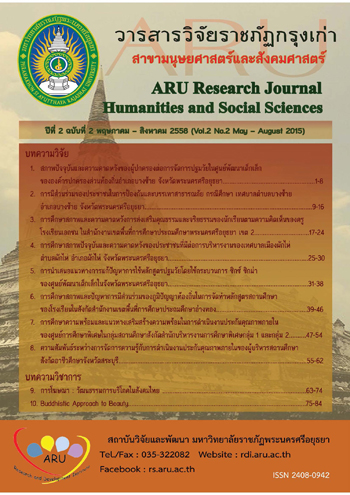Buddhistic Approach to Beauty
Main Article Content
บทคัดย่อ
Beauty, which is one of the three ultimate values, besides truth and goodness, has always charmed and challenged the spirit of man. From the immemorial time, human being tried to investigate the nature of beauty. This resulted in the variation of the concept of beauty. Sometimes the concept of beauty is confined to objective qualities, sometimes to subjective faculties and sometimes to the synthesis of both. Thus, it seems that there is no absolute view about the concept of beauty. However, almost all aesthetic theories accept that beauty is not an immediate property of things; it involves a relation to the mind. In other words, it is a pleasant feeling and whatever creates this kind of feeling contains beauty. According to Buddhism, beauty is neither a fixed concept nor a quality which can exist eternally. Beauty can be perceived as a part of phenomena in the interrelated, ever-changing world. That is, from the point of view of aniccatā, beauty is the product of human creativity, and from the point of view of Śūnyatā, beauty is aesthetic impression.
Article Details
อยู่ระหว่างการปรับปรุง (ลิขสิทธิ์และการรับผิดชอบ)
References
2 B.G. Gokhale, “New Light on Early Buddhism”, Bombay: Popular Prakashan, 1994.
3 Samyutta Nikāya I, London: Pāli Text Society.
4 Peter Harvey, “An Introduction to Buddhism: Teaching, History and Practices”, London: Cambridge University Press, 1990.
5 K.P. Sinha, “Nairātmya-Vāda: The Buddhist Theory of Not-Self”, Culcutta: Sanskrit Book Depot (p) LTD, 1982.
6 A. Adikari, “Sambhasha”, Sri Lanka: Srimaalee Offset Printers, 1991.
7 The Harvard Classics, “Buddhist Writings”, Retrieved April 19, 2015, from http:// www.bartleby.com>...>Buddhist Writings.
8 Venerable Mahathere Nauyane Ariyadhamma, “The Short Analysis of Kamma” Retrieved April 19, 2015, from http://www.dhammatalks.net.
9 Samyutta Nikāya II, London: Pāli Text Society.
10 Vinaya Pitaka, Cullavagga, Oxford: Pāli Text Society.
11 B.G. Gokhale, “New Light on Early Buddhism”, Bombay: Popular Prakashan, 1994.
12 Angraj Chaudhary, “Comparative Aesthetics: East and West”, Delhi: Eastern Book Linkers, 1991.
13 Anguttara Nikāya I, London: Pāli Text Society.
14 Ibid.
15 Ananda K. Coomaraswamy, “Buddha and the Gospel of Buddhism”, New Delhi: Munshiram Manoharlal Publications Pvt. Ltd., 2003.
16 Angraj Chaudhary, “Essays on Buddhism and Pãli Literature”, Delhi: Eastern Book Linkers, 1994.
17 Bimala Churn Law, “Buddhist Woman”. Retrieved April 11, 2015, from http://www.budsas.org/ebud/ebdha204.htm
18 Linda Covill, “A Metaphorical Study of Saundarananda”, Delhi: Motilal Banarsidass Publishers Private Limited, 2009.
19 Kathryn R. Blackstone, “Women in the Footsteps of the Buddha”, Delhi: Motilal Banarsidass Publishers Private Limited, 2000.

